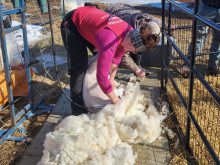SMITHERS, B.C. – Tight feeder markets are forecast for the coming year, which could prompt competitive bidding among feedlots, an industry analyst says.
Record numbers of heifers have been slaughtered in Canada so the supply of new calves will be tight. Feedlots will have to start buying more lightweight calves.
“We have pushed a lot more heifers through in this cycle than we ever have before,” said Anne Dunford of Canfax, at the British Columbia Cattlemen’s Association meeting held here May 27-29.
Heifer numbers for 1998 showed a record 85 percent of available females were fed and killed compared to the annual average of 65 percent. In 1995, 55 percent were killed.
Read Also

Charges laid after cattle theft
Saskatchewan RCMP lay two charges against a man after six cattle went missing.
That means fewer females are in breeding herds so there are fewer replacement calves. It’s part of Canadian cattle industry downsizing, said Dunford. Liquidation will likely bottom out in 2001 and expansion will start again.
“This cycle is not one of those spikes like you saw in the mid-’70s. This one looks like it’s going to be a lot flatter, which is good for the industry,” said the Canfax analyst.
Next year and beyond she expects cattle numbers to continue dropping so prices should rebound. Cow liquidation has returned to normal levels of about 10 percent.
Last June, Saskatchewan had a cow run due to drought conditions. That is not expected to repeat itself this year because of adequate rain for pastures.
This fall fewer heifers are likely to be shipped as cow-calf producers check the age of their cows, so breeding heifer numbers could be limited.
“If we see same major retention occur this fall, it is still going to be too soon to change the numbers for 1999,” Dunford said.
Heifers are being placed in Alberta’s swelling feedlot system where last year 2.4 million cattle were finished.
Alberta feeds 70 percent of the nation’s cattle. Saskatchewan and Manitoba feed about 10 percent between them and British Columbia feeds about one percent.
There are also record high kill levels.
Alberta slaughtered 53,000 head last week, although the average weekly kill is less than 40,000 head. The national kill for the same week was around 74,000. Alberta will process close to 2.5 million head in 1999.
“Those are the biggest kills we’ve seen in over 15 years in this country,” Dunford said.
IBP-Lakeside at Brooks, Alta., and Cargill Foods at High River, Alta., have moved to double shifts and some other plants have worked through holidays to keep up with the stream of cattle.
Kill numbers generated record amounts of beef, exacerbated by record carcass weights. The average steer carcass was 800 pounds.
“When you average that for the year, you know that there’s a whole bunch that weighed more than that,” she said. That extra weight in the supply chain was the equivalent of 133,000 extra head.
Cattle have gained an average 8.5 pounds per year since 1975 so fewer cows are able to produce more beef.
This year, beef production should be down by three percent, Dunford said.

















